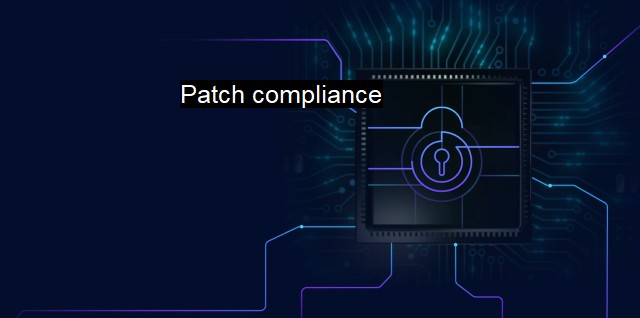What is Patch compliance?
The Significance of Patch Compliance in Today's Cybersecurity Landscape: Securing Your Business and Data from Potential Threats
Patch compliance is an essential piece of cybersecurity, it refers to the process of ensuring that various systems and software applications within a business network are upgraded to the latest versions, a process often accomplished through software patches. These patches are an essential line of defense against cybercriminals because they often address vulnerabilities or bugs in previous versions of the software that could be exploited to gain unauthorized access to a network.Patches update the software or operating system, implementing new features and fixing potential vulnerabilities that cybercriminals could exploit. Cybersecurity breaches frequently occur when businesses are noncompliant with patch management, because this enables malicious actors to infiltrate networks and systems through these known security flaws. This flaw-based actionable intelligence assists cybercriminals in conducting targeted attacks more effectively, resulting in profound consequences for companies, including data theft, financial loss, damage to reputation, and even potential closure of the business.
Patch compliance not only involves applying patches but measuring and ensuring that all systems and applications are properly patched. It includes tracking which patches have been applied, which have not, why they were rejected, and what the potential vulnerabilities are in the system. The goal of patch management is not merely to apply patches blindly but to apply them purposefully, ensuring that systems are both secure and optimized for performance.
Patch compliance generally falls under the purview of a company's IT department, which is tasked with regularly updating software and performing vulnerability assessments. Failing to prioritize and enforce compliance with patch updates can render the most advanced security systems and protocols ineffective. Cyber attackers are ingenious and always on the lookout for new vulnerabilities. Therefore, it is not enough just to set and forget a set of security controls and hope they work.
Part of patch compliance involves risk assessment – realizing which systems, if attacked, could bring the entire business operation to a halt. Companies must prioritize those systems and ensure they are routinely and quickly patched. By following a patch compliance routine and regularly uploading patches across all systems, firms demonstrate due diligence in minimizing their cyber risks.
Another aspect of patch compliance, particularly for larger businesses or those in industries that involve sensitive information, is the need for reporting. Documentation proving that compliance does not end at antivirus software installation, instead, it also involves updating, servicing, and applying patches to black-hole potential vulnerabilities.
In general, patch compliance is an important line of defense in the fight against cyber threats. Although it is not the only aspect of a robust cybersecurity plan, its importance cannot be undervalified. Concurrently, various strategies can guarantee patch compliance, including automated patch management systems, outsourcing patch management to a managed service provider, or implementing strict internal controls regarding patch application and monitoring.
Notably, patch compliance is not a one-time event, but a continuous and vigilant process. Ensuring regular application of security patches is obligatory to maintain the highest possible level of security and keep up with the rapidly escalating level of cyber threats. The evolving sophistication of modern threats necessitates an equally evolving security environment, staying one step ahead in both battle and cybersecurity requires proactive strategy – in this case, consistent patch compliance.
Through all of these practices, businesses of all sizes can rise to the challenge of patch compliance, winning a significant victory in the war against cybercrime. Without a doubt, patch compliance increases protection against the constant onslaught of new system threats, strengthens security posture and resilience to instantly handle unexpected events, and gives both companies and their customers a sense of safety.

Patch compliance FAQs
What is patch compliance in cybersecurity?
Patch compliance refers to the level of adherence of a system to the latest security patches and updates to protect against known vulnerabilities in the system's software.What are the consequences of noncompliance with patching in antivirus software?
Noncompliance with patching in antivirus software can expose a system to security risks and cyber-attacks. Hackers can exploit known vulnerabilities in software that has not been updated, leading to data breaches, malware infections, and other security incidents.How can I ensure patch compliance in my organization's antivirus software?
To ensure patch compliance, organizations should create a patch management policy that outlines the procedures for assessing, testing, and deploying patches in their systems. Regular monitoring and reporting of patch compliance levels can also help identify areas that need improvement.What is the role of antivirus software in patch compliance in cybersecurity?
Antivirus software plays a critical role in patch compliance as it helps identify vulnerabilities and patching needs in a system. It also provides real-time protection against malware and other threats that exploit unpatched software. Therefore, it is important to ensure that antivirus software is always updated with the latest patches and definitions.| | A | | | B | | | C | | | D | | | E | | | F | | | G | | | H | | | I | | | J | | | K | | | L | | | M | |
| | N | | | O | | | P | | | Q | | | R | | | S | | | T | | | U | | | V | | | W | | | X | | | Y | | | Z | |
| | 1 | | | 2 | | | 3 | | | 4 | | | 7 | | | 8 | | |||||||